Input interpretation

isobutylene
Chemical names and formulas
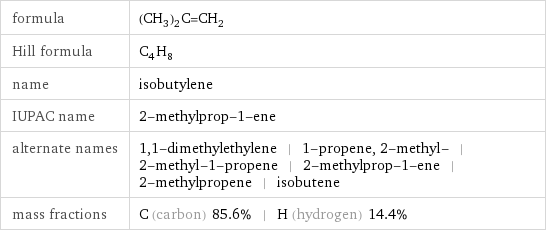
formula | (CH_3)_2C=CH_2 Hill formula | C_4H_8 name | isobutylene IUPAC name | 2-methylprop-1-ene alternate names | 1, 1-dimethylethylene | 1-propene, 2-methyl- | 2-methyl-1-propene | 2-methylprop-1-ene | 2-methylpropene | isobutene mass fractions | C (carbon) 85.6% | H (hydrogen) 14.4%
Lewis structure
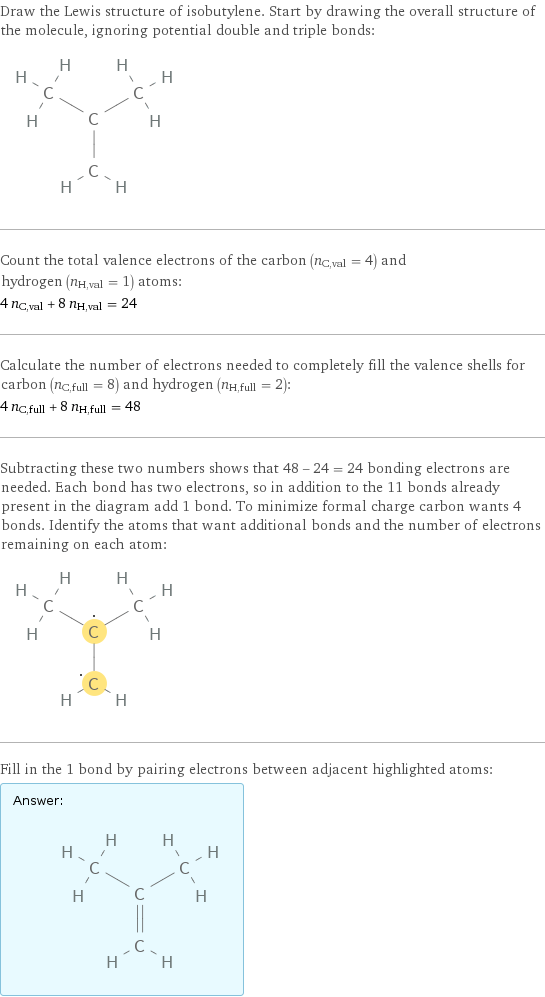
Draw the Lewis structure of isobutylene. Start by drawing the overall structure of the molecule, ignoring potential double and triple bonds: Count the total valence electrons of the carbon (n_C, val = 4) and hydrogen (n_H, val = 1) atoms: 4 n_C, val + 8 n_H, val = 24 Calculate the number of electrons needed to completely fill the valence shells for carbon (n_C, full = 8) and hydrogen (n_H, full = 2): 4 n_C, full + 8 n_H, full = 48 Subtracting these two numbers shows that 48 - 24 = 24 bonding electrons are needed. Each bond has two electrons, so in addition to the 11 bonds already present in the diagram add 1 bond. To minimize formal charge carbon wants 4 bonds. Identify the atoms that want additional bonds and the number of electrons remaining on each atom: Fill in the 1 bond by pairing electrons between adjacent highlighted atoms: Answer: | |
3D structure
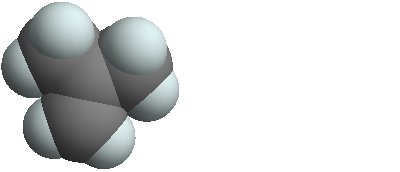
3D structure
Basic properties
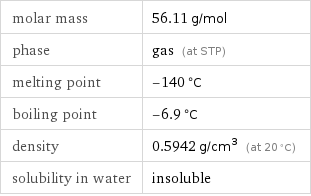
molar mass | 56.11 g/mol phase | gas (at STP) melting point | -140 °C boiling point | -6.9 °C density | 0.5942 g/cm^3 (at 20 °C) solubility in water | insoluble
Units

Gas properties (at STP)

density | 0.5942 g/cm^3 (at 20 °C) vapor density | 2 (relative to air) molar volume | 94.4 cm^3/mol surface tension | 0.0123 N/m refractive index | 1.5072 dynamic viscosity | 8.084×10^-6 Pa s (at 25 °C)
Units

Thermodynamic properties
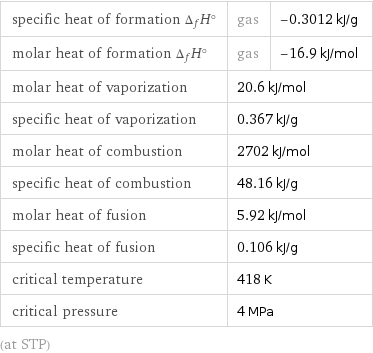
specific heat of formation Δ_fH° | gas | -0.3012 kJ/g molar heat of formation Δ_fH° | gas | -16.9 kJ/mol molar heat of vaporization | 20.6 kJ/mol | specific heat of vaporization | 0.367 kJ/g | molar heat of combustion | 2702 kJ/mol | specific heat of combustion | 48.16 kJ/g | molar heat of fusion | 5.92 kJ/mol | specific heat of fusion | 0.106 kJ/g | critical temperature | 418 K | critical pressure | 4 MPa | (at STP)
Phase diagram

Phase diagram
Units

Chemical identifiers
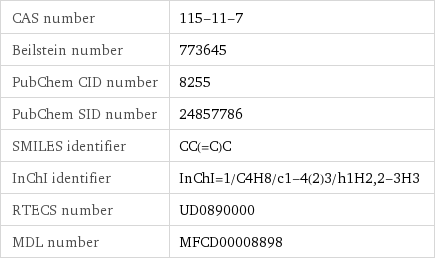
CAS number | 115-11-7 Beilstein number | 773645 PubChem CID number | 8255 PubChem SID number | 24857786 SMILES identifier | CC(=C)C InChI identifier | InChI=1/C4H8/c1-4(2)3/h1H2, 2-3H3 RTECS number | UD0890000 MDL number | MFCD00008898
NFPA label

NFPA label
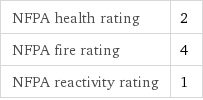
NFPA health rating | 2 NFPA fire rating | 4 NFPA reactivity rating | 1
Safety properties
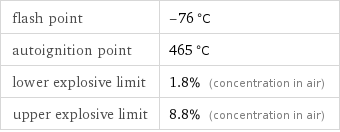
flash point | -76 °C autoignition point | 465 °C lower explosive limit | 1.8% (concentration in air) upper explosive limit | 8.8% (concentration in air)

DOT hazard class | 2.1 DOT numbers | 1055
Toxicity properties

RTECS classes | other